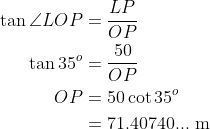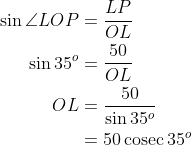A boat has a speed relative to the water at 3m/s. The boat points 35 degrees to the shore, moving upstream on a river flowing 0.75m/s. How much time does it take for the boat to reach the opposite shore if it the river is 50m wide?
Sounds like a vectors question in the MX1 syllabus, so I will offer first the solution that applies vectors. If this is meant as a question at the Advanced Maths level, a different method (described below) is needed.
MX1 Approach
Let's assume that the two banks of the river are straight lines and are parallel, so that there is fixed perpendicular distance of 50 m between them.
Take the origin at the boat's starting position with the river bank being the

-axis so that the far bank is located along the line

.
Now, take the river as flowing from right to left, so that the positive

-direction corresponds to upstream. It follows that, since the water is flowing in the negative direction at a speed of 0.75 m s
-1, the vector corresponding to the flow of the river is

.
The boat is travelling in a direction that is inclined at and angle of 35
o from the shore and in the upstream direction. The unit vector for this direction is

Since the boat is moving at 3 m s
-1 relative to the water, the boat's velocity relative to the water is a vector along the given direction and with magnitude of 3. That is, it is
)
Let the velocity of the boat across the river (relative to the bank) be

, which is made up of the motion of the boat relative to the water and the motion of the water itself. Consequently,
 + -0.75\overrightarrow{i} \\ &= \left(3\cos{35^o} - \frac{3}{4}\right)\overrightarrow{i} + 3\sin{35^o}\overrightarrow{j} \\ &= \frac{3}{4}\left(4\cos{35^o} - 1\right)\overrightarrow{i} + 3\sin{35^o}\overrightarrow{j} \end{align*})
Taking the origin of time (

) as the time when the boat departs, then the position vector of the boat at time

,

, is found by integrating

with respect to

:
\overrightarrow{i} + 3t\sin{35^o}\overrightarrow{j})
The boat reaches the far bank when

, where

is the distance that the boat has travelled along the bank relative to its starting position. Equating the

components allows the time taken to cross the river to be determined:
} \end{align*})
----
Now, it was not requested, but we can use the above result to find the distance

as it also occurs at the time when the boat reaches the far bank:
 \times \frac{50}{3\sin{35^o}} \\ &= \frac{4\cos{35^o} - 1}{2} \times \frac{25}{\sin{35^o}} \\ &= \frac{25(4\cos{35^o} - 1)}{2\sin{35^o}} \\ &= 49.614315... \text{ m} \\ &\approx 49.6 \text{ m (1 dec. pl.)} \end{align*})
So, the boat takes 29.1 s to cross the river, and lands at a position 49.6 m upstream from the point on the far bank opposite its starting point.
----
We can do a check to estimate the solution by neglecting the flow of the river. If the river was not flowing, the path would be a straight line with

being the origin,

being the point on the other bank (ie. on the line

) where the boat lands, and

being the point on the starting bank which is directly opposite

- in other words, where

. From the given information,

,

, and so

The river flow is forcing the boat downstream, so we know it will actually land downstream of this point 71.4 m upstream, which is consistent with the above calculation showing an arrival position of 49.6 m along the opposite bank in the upstream direction.
----
Advanced Maths rather than MX1 approach
The above triangle trigonometry allows the distance

to be calculated, either using Pythagoras' Theorem
 \\ &= 50^2\text{cosec}^2{35^o} \\ OL &= 50\,\text{cosec}\,35^o \qquad \qquad \text{as $OL > 0$} \end{align*})
or by trigonometry

And the boat travels along

at 3 m s
-1, and so the time taken will be

Now, the boat will be pushed downstream by the river flow, which will alter the path and the landing position. However, the motion can be considered as having a component along the river and a perpendicular motion across it. The river flow will alter the former but not the latter, and it follows that the time taken for the crossing is the same. The only effect of the river flow is to change the landing position by a distance of

Consequently, the landing position will be


